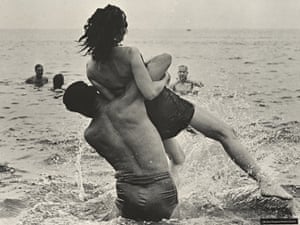 |
| Garry Winogrand, Coney Island Bathers, New York, 1952 |
Whilst doing my research into Garry Winogrand's work I came across an article featuring a photograph of his that mentioned an exhibition it was included in. I decided to then read further into The Family of Man exhibition which was curated by Edward Steichen, as it's themes very much relate to those I am able to explore in this relationship project.
The Family of Man was first shown in 1955 at the Museum of Modern Art. After the two world wars Steichen concieved the exhibition to promote world peace and equality. Focusing on the universalities that unite people across all cultures, such as love and death. The exhibition which was presented like a photoessay brought together 503 photographs taken by 273 photographers, from 68 different countries.
The photographs were presented on temporary walls, poles and hung from wires in the exhibition space to guide visitors to read the images individually and also in a linear way across each theme. This photo essay is curated in an even more linear way in the exhibition book which I took out of the library to read. The photographs and text in the book take you on a journey showing the cycles and developments of human life. The pages take you through the exhibition themes such as childbirth, love, war, education, death and many more facets of human life that we experience across all cultures. Despite there being some poetry and other pieces of text written in both the book and in captions throughout the exhibition, it was intended to be understood without the need for written words which is why there are such clear themes in The Family of Man.
I think it is quite clear that the photographs were chosen by Steichen based on their narrative quality, their ability to make you feel something in response to the subject matter captured and also in contributing to the effect of the exhibition as a whole. The way Steichen has grouped the photographs together throughout the exhibition strengthens the accompanying text, creating a richer story about human life.
 |
"The function and mission of photography is to explain man to man and man to himself." - Edward Steichen
|
The strength of both the individual narratives of each photograph and the entire narrative of the exhibition that Steichen has curated, has really inspired me to think more about how my own photographs of different relationships could link together under one theme, or illustrate a particular message or idea.
Personally I am drawn to humanist documentations of human life through photography and this exhibition is a collection of such. However in this particular case I can appreciate many of the images individually however all together like this it doesn't do a lot for me. As it just illustrates the human condition more than anything in a very rigid editorial manner, showing that we all live and die the same way. The Family of Man also represents a mainly western viewpoint as over half of all the photographers who contributed images to the exhibition were Americans (163 out of 273). You could argue that because of this more western centric perspective that it is harder to show differences when most of the photographers will have had a similar background which therefore will affect how they approach their subject matter.
I can appreciate however the ambition and success of this exhibition and how it allowed many people for the first time to see images of people living in Eastern Asian countries. It terms of my own work this exhibition and its aims has made me think a lot more about what I want to say with my own images. I think in this case it is good that I have been able to identify what doesn't work for me about this photo essay, because I can apply these thoughts to my own work and ideas.










No comments:
Post a Comment